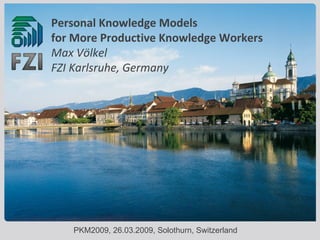Personal Knowledge Models for More Productive Knowledge Workers
- 1. Personal Knowledge Models for More Productive Knowledge Workers Max V?lkel FZI Karlsruhe, Germany PKM2009, 26.03.2009, Solothurn, Switzerland
- 2. Abstract We motivate how personal knowledge models can make knowledge workers more productive. The external representation can help him to tackle typical cognitive limits. They do so by allowing a knowledge worker to efficiently and effectively model her or his personal knowledge in a mix of informal and formal knowledge. As a result, more knowledge can be re-used cheaper and hopefully more complex problems can be tackled.
- 3. More Productive Knowledge Workers The knowledge-based organisation is no more effective than the sum of its knowledge workers' effectiveness . (Davenport) Knowledge management is shifting from a focus on enterprise productivity to a focus on individual knowledge worker productivity (Gartner 2002) ? Increasing the individual knowledge worker productivity increases the productivity of the organisation
- 4. Personal Knowledge Management PKM investigates the use of methods and tools to amplify the abilities of the individual to work better with knowledge . (V?lkel)
- 6. Personal Knowledge Management... ... communication with yourself Internalisation Externalisation Combination Combination
- 7. Basic unit: A Knowledge Cue , ``a note to self'‘ A knowledge cue is any kind of storable symbol, pattern or artefact, created with the intent to be used by its creator, to re-evoke a previously experienced mental state (activated knowledge), when viewed or used otherwise. Does it contain knowledge? Physical cues: Limited modifiability and scalability ? Digital knowledge cues
- 8. Knowledge cues can vary in size and ... Degree of structure Heiko works for the FZI. (Plain text) Query: ? Heiko “ (Full-text search) Heiko works for the <company>FZI</company> (XML) Query: ?//company “ (XPath) Degree of formality (Heiko, works-for, FZI), (FZI, is located in, Germany) (RDF) Query: ? ?who, works-for, ?company. ?company, located-in, Germany “ (SPARQL) More structure, more formality ? more automatic processing (queries, transformations)
- 9. Knowledge cues can vary in costs More structure, more formality ? more costs You Your Money - gone
- 10. Processes in PKM Creation Organise, Formalize, Refine Externalisation Retrieval (search own + others) Usage Share 1 2 4 6 3 5 Based on works of Marc E. Nissen, 2006, WM Potsdam
- 11. Personal Knowledge Model A personal digital knowledge model is a digital artifact, which represents a set of knowledge cues. The knowledge cues can vary in size, structuredness and degree of formality. A knowledge cue is either (a) a piece of content, containing plain text, semi-structured text, or arbitrary binary content such as images or desktop objects, or (b) a connection between other knowledge cues. Such connections can be unspecified relations, directed hyperlinks and formal statements.
- 12. Requirements Unified Model Import from a number of existing formats Step-wise Formalisation Text ? more and more structured text Links ? typed links ? semantically typed links Knowledge Model Refactoring Note: Ignored in many approaches and research papers Knowledge Model Maintenance System should help user in removing or updating old knowledge
- 13. Summary. The idea is to Amplify the abilities of the individual to work better with knowledge by managing a set of knowledge cues in a unified knowledge model with step-wise formalisation to let the user find the sweet spot between effort and benefit.
- 14. Thank You. Max V?lkel FZI Karlsruhe, Germany PKM2009, 26.03.2009, Solothurn, Switzerland














